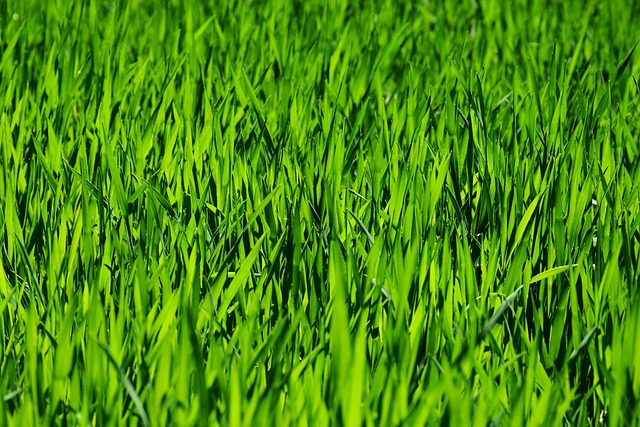Effective lawn care and landscaping are essential for a visually appealing and functional outdoor space that harmonizes with your lifestyle and environmental considerations. A well-maintained lawn is the cornerstone of this, demanding tailored care to suit local soil types and weather patterns, ensuring the health and growth of grass varieties like Kentucky bluegrass or fescue. Soil preparation, including pH level adjustments and enrichment with organic matter, sets the stage for robust root development. Regular aeration and consistent maintenance—such as precise mowing heights, efficient irrigation systems, and integrated pest management—are crucial. The strategic application of mulch and compost aids in moisture conservation and nutrient replenishment. Integrating landscaping elements like flower beds and garden paths with hardscapes such as patios or retaining walls enhances the lawn's functionality and beauty. Embracing sustainable practices, including the use of drought-resistant plants and native species for water conservation and biodiversity, aligns with eco-friendly principles. This holistic approach to lawn care and landscaping ensures a lush, resilient outdoor living space that is both aesthetically pleasing and environmentally conscious.
Embark on a journey through the nuances of outdoor space design with an emphasis on the essential elements that cultivate a thriving lawn. This article delves into strategic planning for effective lawn care and landscaping, offering practical steps to bring your green visions to life. Uncover the secrets to a lush, healthy landscape that complements your home’s aesthetic while promoting environmental well-being. With expert insights on lawn care and landscaping, transform your outdoor area into an oasis of serenity and beauty.
- Essential Elements of a Thriving Lawn in Outdoor Space Design
- Strategic Planning for Effective Lawn Care and Landscaping
- Building Your Vision: Implementing Landscaping Ideas with Practical Steps
Essential Elements of a Thriving Lawn in Outdoor Space Design

A thriving lawn serves as the cornerstone of any well-designed outdoor space, blending functionality with aesthetic appeal. Effective lawn care and landscaping hinge on understanding the unique conditions of your environment, including local soil types, climate patterns, and the specific grass varieties that prosper in these settings. The essential elements for a flourishing lawn begin with the selection of a suitable grass species, such as Kentucky bluegrass or fescue, which are known for their resilience and adaptability. These grasses should be sown at the optimal time to ensure they establish strong root systems before extreme weather conditions.
The soil preparation is another critical aspect of lawn care and landscaping. It involves testing the pH levels and amending the soil with organic matter to achieve a balanced environment that promotes healthy growth. Aeration, which allows air, water, and nutrients to reach the grass roots, is also an important practice. Beyond these fundamentals, regular maintenance routines are vital, including consistent mowing at the right height for the grass type, proper irrigation to maintain soil moisture without over-saturating, and proactive integrated pest management to address both weeds and pests. Additionally, the strategic use of mulch and compost can enhance lawn health by retaining moisture and adding beneficial nutrients back into the soil. By integrating these elements with careful planning and attention to detail in landscaping, homeowners can create a lush, vibrant lawn that serves as a welcoming and attractive outdoor living space.
Strategic Planning for Effective Lawn Care and Landscaping

Engaging in strategic planning for effective lawn care and landscaping is essential to cultivating a thriving outdoor space. A well-maintained lawn serves as the foundation of any landscape design, enhancing both the aesthetic appeal and environmental health of your property. To initiate this process, start by assessing your local climate and soil conditions, as these factors significantly influence grass type selection and maintenance routines. Implementing a tailored lawn care schedule that includes regular mowing, fertilization, aeration, and proper irrigation will foster a resilient and vibrant lawn. Additionally, consider the layout of your outdoor space when planning landscaping elements such as flower beds, garden paths, and hardscapes like patios or retaining walls. These elements not only complement the lawn but also serve functional purposes, such as erosion control and creating visual interest throughout the seasons.
Effective lawn care and landscaping go hand in hand with sustainable practices that protect natural resources while enhancing the beauty of your outdoor environment. Integrate drought-resistant plants and native species to minimize water usage and encourage biodiversity. Employ organic methods for pest control and weed management to maintain a healthy ecosystem. By combining these eco-friendly approaches with thoughtful design elements, you can achieve a landscape that is both aesthetically pleasing and environmentally responsible. Regular upkeep and adaptive management will ensure your lawn and landscaping flourish year after year.
Building Your Vision: Implementing Landscaping Ideas with Practical Steps

Crafting an outdoor space that brings your vision to life involves a blend of creativity and practicality. As you embark on this transformative journey, lawn care and landscaping play pivotal roles in shaping the environment. Begin by envisioning the desired ambiance for your outdoor area, whether it’s a serene retreat or an entertaining space for gatherings. Research and gather inspiration from various sources such as landscaping magazines, online galleries, and community gardens to formulate a clear idea of what you wish to create. Once inspired, the next step is to plan the layout, considering factors like sunlight exposure, soil type, and drainage. This planning phase also involves selecting plants and materials that complement your home’s architectural style while fitting within your budget constraints.
With your concept in hand, it’s time to translate your ideas into actionable landscaping projects. Start with the basics of lawn care, ensuring a healthy foundation for your outdoor space. This includes regular mowing, fertilization, and pest control to maintain a lush, green lawn. As you proceed, tackle larger elements such as hardscaping features like pathways, patios, or water features, which can be both aesthetically pleasing and functional. Implementing these elements requires careful measurement and precise execution. For example, when laying pavers for a patio, proper preparation of the base is crucial to prevent future sinking or shifting. Similarly, selecting native plants for your garden beds not only adds local charm but also reduces maintenance and supports the local ecosystem. As you progress through each phase of landscaping, remember to adapt your approach based on seasonal changes and regional climate conditions. By combining meticulous lawn care with thoughtful landscaping choices, you can transform your vision into a thriving outdoor oasis that offers both beauty and tranquility.
In conclusion, transforming your outdoor space into a thriving sanctuary hinges on incorporating essential elements that support a flourishing lawn. Strategic planning and practical implementation are key components of successful lawn care and landscaping. By understanding the needs of your lawn and creatively envisioning its potential, you can craft an outdoor oasis that not only elevates your property’s aesthetic but also fosters biodiversity and provides a serene retreat from daily life. Embrace the journey of lawn care and landscaping to ensure your green space remains vibrant and inviting throughout the seasons. For more insights on achieving this harmony, consider our comprehensive guide on lawn care and landscaping—your garden’s growth is just a plan away.
